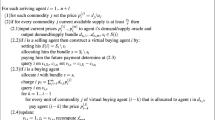Abstract
In many resource allocation problems, economy efficiency must be taken into consideration together with social equality, and price rigidities are often made according to some economic and social needs. We investigate the computational issues of dynamic mechanisms for selling multiple indivisible objects under price rigidities. We propose a multiple agents protocol and algorithm with polynomial time complexity that can achieve the over-demanded sets of items, and then introduce a dynamic mechanism with rationing to discover constrainedWalrasian equilibria under price rigidities in polynomial time. We also address the computation of buyers’ expected profits and items’ expected prices, and discuss strategical issues in the sense of expected profits.





Similar content being viewed by others
Notes
Note that since upper bound prices are often set for the sake of equality between social members (who have some but limited pay ability), they generally accompany a limit to the number of resources one member can get.
Suppose there are k buyers drawing lots for the right to buy item a. Then the lot is fair if each one of these buyers has 1/k chance of winning the lot.
References
Ausubel LM (2006) An efficient dynamic auction for heterogeneous commodities. Amer Econ Rev:602–629
Bahrammirzaee A, Chohra A, Madani K (2013) An adaptive approach for decision making tactics in automated negotiation. Appl Intell 39(3):583–606
Bouveret S, Lang J (2011) A general elicitation-free protocol for allocating indivisible goods. In: Proceedings of international joint conference on artificial intelligence, pp 73–78
Brams S, Fishburn P (2002) Fair division of indivisible items between two people with identical preferences. SocialChoice Welfare 17:247–267
Brams SJ, Feldman M, Lai JK, Morgenstern J, Procaccia AD (2012) On maxsum fair cake divisions. In: Proceedings of the 26th national conference on artificial intelligence. Toronto, pp 1285–1291
Branzei S, Procaccia AD, Zhang J (2013) Externalities in cake cutting. In: Proceedings of the twenty-third international joint conference on artificial intelligence. AAAI Press, pp 55–61
Brazier FM, Cornelissen F, Gustavsson R, Jonker CM, Lindeberg O, Polak B, Treur J (2004) Compositional verification of a multi-agent system for one-to-many negotiation. Appl Intell 20(2):95–117
Chen Y, Lai JK, Parkes DC, Procaccia AD (2013) Truth, justice, and cake cutting. Games Econ Behav 77(1):284–297
Chevaleyre Y, Endriss U, Maudet N (2010) Simple negotiation schemes for agents with simple preferences: sufficiency, necessity and maximality. Auton Agents Multi-Agent Syst 20(2):234–259
Cohler YJ, Lai JK, Parkes DC, Procaccia AD (2011) Optimal envy-free cake cutting. In: Proceedings of the 25th national conference on artificial intelligence. San Francisco, pp 626–631
Cramton P, Shoham Y, Steinberg R (2006) Combinatorial auctions. MIT press
Fahad M, Boissier O, Maret P, Moalla N, Gravier C (2014) Smart places: multi-agent based smart mobile virtual community management system. Appl Intell:1–19
Gul F, Stacchetti E (1999) Walrasian equilibrium with gross substitutes. J Econ Theory 87(1):95–124
Gul F, Stacchetti E (2000) The english auction with differentiated commodities. J Econ Theory 92(1):66–95
Guo M, Deligkas A (2013) Revenue maximization via hiding item attributes. In: Proceedings of the twenty-third international joint conference on artificial Intelligence. AAAI Press, pp 157–163
Hartline J, Yan Q (2011) Envy, truth, and profit. In: Proceedings of the 12th ACM conference on electronic commerce. ACM, pp 243–252
Kalinowski T, Narodytska N, Walsh T (2013) A social welfare optimal sequential allocation procedure. In: Proceedings of the twenty-third international joint conference on artificial intelligence. AAAI Press, pp 227–233
Kalinowski T, Narodytska N, Walsh T, Xia L (2012) Strategic behavior in a decentralized protocol for allocating indivisible goods. In: Proceedings of the 4th international workshop on computational social choice, vol 12. Kraków, pp 251–262
Kalinowski T, Narodytska N, Walsh T, Xia L (2013) Strategic behavior when allocating indivisible goods sequentially. In: Proceedings of the 27th national conference on artificial intelligence. Bellevue, pp 452–458
Lehmann B, Lehmann D, Nisan N (2001) Combinatorial auctions with decreasing marginal utilities. In: Proceedings of the 3rd ACM conference on electronic commerce. ACM, pp 18–28
Likhodedov A, Sandholm T (2005) Approximating revenue-maximizing combinatorial auctions. In: Proceedings of the 20th national conference on artificial intelligence, vol 5. Pittsburgh, pp 267–274
Lumet C, Bouveret S, Lemaitre M (2012) Fair division of indivisible goods under risk. In: Proceedings of the twentieth European conference on artificial intelligence. IOS Press, pp 564–569
Mirchevska V, Luṡtrek M, BeŻek A, Gams M (2014) Discovering strategic behaviour of multi-agent systems in adversary settings. Comput Inf 33(1):79–108
Procaccia AD (2013) Cake cutting: not just child’s play. Commun ACM 56(7):78–87
Rothkopf MH, Pekeċ A, Harstad RM (1998) Computationally manageable combinational auctions, vol 44
Sandholm T (2002) Algorithm for optimal winner determination in combinatorial auctions, vol 135
Schrijver A (2003) Combinatorial optimization: polyhedra and efficiency, vol 24. Springer
Sun N, Yang Z (2009) A double-track adjustment process for discrete markets with substitutes and complements. Econometrica 77(3):933–952
Talman D, Yang Z (2008) A dynamic auction for differentiated items under price rigidities. Econ Lett 99(2):278–281
Wang JJD, Zender JF (2002) Auctioning divisible goods. Econ Theory 19:673–705
Zhang D, Huang W, Perrussel L (2010) Dynamic auction: a tractable auction procedure. In: Proceedings of the 24th national conference on artificial intelligence. Atlanta, pp 935–940
Acknowledgments
This work is supported partly by the National Natural Science Foundation of China (Grant No. 61105039,61173035,61472058), and the Program for New Century Excellent Talents in University (Grant No. NCET-11-0861).
Author information
Authors and Affiliations
Corresponding author
Rights and permissions
About this article
Cite this article
Huang, W., Liu, H., Dai, G. et al. A tractable multiple agents protocol and algorithm for resource allocation under price rigidities. Appl Intell 43, 564–577 (2015). https://doi.org/10.1007/s10489-015-0663-0
Published:
Issue Date:
DOI: https://doi.org/10.1007/s10489-015-0663-0




